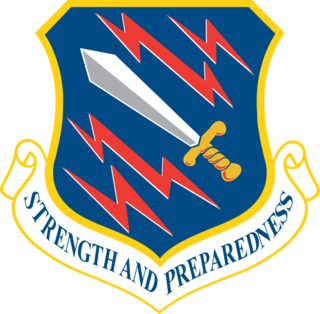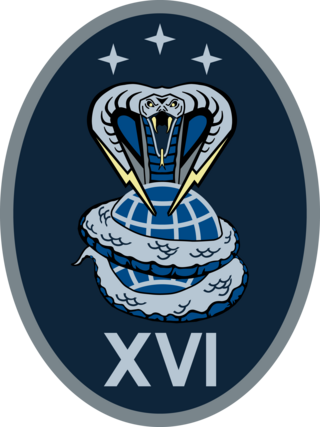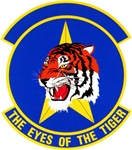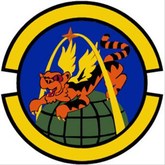
The United States Space Force's 10th Space Warning Squadron, is a missile warning unit located at Cavalier Space Force Station, North Dakota operating the AN/FPQ-16 Perimeter Acquisition Radar Attack Characterization System.

The 2nd Space Operations Squadron is a United States Space Force unit responsible for operating the Global Positioning System (GPS) satellite constellation, which provides global navigation, time transfer, and nuclear detonation detection. It is a component of Space Operations Command's Positioning, Navigation, and Timing Integrated Mission Delta (Provisional) and headquartered at Schriever Space Force Base, Colorado.

The 21st Wing is an inactive wing of the United States Air Force.

The 20th Space Surveillance Squadron is a Space Delta 2 unit located at Eglin Air Force Base, Florida with the mission to execute multiplatform, tactical space warfighting domain characterization, recognition, and responsiveness to achieve 21st Space Wing and United States Space Command intent. The unit, formerly designated the 20th Space Control Squadron, was renamed on 25 March 2022.

The United States Space Force's 4th Electromagnetic Warfare Squadron is an offensive space electromagnetic warfare unit formerly located at Holloman Air Force Base, New Mexico, stood up operations 1 July 2014 at Peterson Space Force Base, Colorado.

The 18th Intelligence Squadron is an intelligence organization of the United States Air Force, located at Buckley Space Force Base, Colorado.

The 13th Space Warning Squadron (13SWS) is a missile warning unit assigned to the United States Space Force and located at Clear Space Force Station 5 miles (8 km) south of Anderson, Alaska

The 16th Electromagnetic Warfare Squadron is an active United States Space Force unit, stationed at Peterson Space Force Base, Colorado as part of the Space Delta 3. The squadron protects critical satellite communication links to detect, characterize, geolocate and report sources of electromagnetic interference on US military and commercial satellites. The squadron also provides combat-ready crews to deploy and employ defensive space electromagnetic warfare capabilities for theater combatant commanders. The squadron is Air Force Space Command's first defensive counterspace unit.

The 1st Test and Evaluation Squadron is a United States Space Force test and evaluation unit, located at Schriever Space Force Base, Colorado. The squadron is tasked with testing and evaluation of command and control systems for Space Operations Command.

The 1st Space Operations Squadron is a United States Space Force unit responsible for space-based space domain awareness. Located at Schriever Space Force Base, Colorado, the squadron operates the Space Based Space Surveillance system, the Advanced Technology Risk Reduction system, the Operationally Responsive Space-5 satellite, and the Geosynchronous Space Situational Awareness Program.

The 3rd Test and Evaluation Squadron is a space test and evaluation unit located at Schriever Space Force Base in Colorado.

The 11th Space Warning Squadron is a United States Space Force missile warning squadron, located at Buckley Space Force Base, Colorado.

The 18th Space Defense Squadron is a United States Space Force Space Domain Awareness unit located at Vandenberg Space Force Base, California. The 18th SDS is tasked with executing command and control of the space surveillance network (SSN), maintaining the resident space object (RSO) database and managing United States Space Command's space situational awareness (SSA) sharing program to United States, foreign government, commercial, and academic entities. The squadron also conducts advanced analysis, sensor optimization, conjunction assessment, human spaceflight support, reentry/break-up assessment, and launch analysis.

The United States Air Force's 2d Command and Control Squadron was an Air Force Space Command command and control unit located at Falcon AFB, Colorado. The 2 CACS commanded passive surveillance systems supporting USSPACECOM and theater warfighters’ requirements through continuous all-weather, day-night surveillance of on-orbit satellites.

The United States Space Force's 5th Electromagnetic Warfare Squadron is a space electromagnetic warfare unit located at Peterson Space Force Base, Colorado.

The 7th Space Warning Squadron (SWS) is the premier Space Domain Awareness sensor on the West Coast. The unit was originally established to guard the U.S. West Coast against sea-launched ballistic missiles from the eastern outskirts of Beale Air Force Base approximately 8 miles (13 km) east of Marysville, California. 7 SWS is a geographically separated unit of Space Delta 4.

The 17th Test and Evaluation Squadron is a United States Space Force test and evaluation unit, located at Schriever Space Force Base, Colorado. The squadron is tasked with testing and evaluating space systems and associated support equipment.

The 30th Operations Group was a group of the United States Space Force. It was assigned to the 30th Space Wing, stationed at Vandenberg Air Force Base, California. It was responsible for all space launch operations from the West Coast of the United States, including all polar launches. It operated the Western Range, which conducts launches for the Space Force, other parts of the Department of Defense, NASA, and private space corporations. In 2021 the 30th Operations Group and the 30th Mission Support Group were inactivated and squadrons assigned to Space Launch Delta 30.

Space Operations Command (SpOC) is the United States Space Force's space operations, cyber operations, and intelligence field command. Headquartered at Peterson Space Force Base, Colorado, it consists of its mission deltas, and garrison commands.

Space Delta 2 is the United States Space Force's space domain awareness and space battle management delta and is headquartered at Peterson Space Force Base, Colorado. Space Delta 2 tracks and monitors all human made objects from low Earth orbit to geosynchronous orbit and further out to deep space. It also partners with the National Oceanic and Atmospheric Administration to provide weather satellite observation for the U.S. Armed Forces. It consists of the 15th Space Surveillance, 18th Space Defense Squadron, 19th Space Defense Squadron, and 20th Space Surveillance Squadron.























